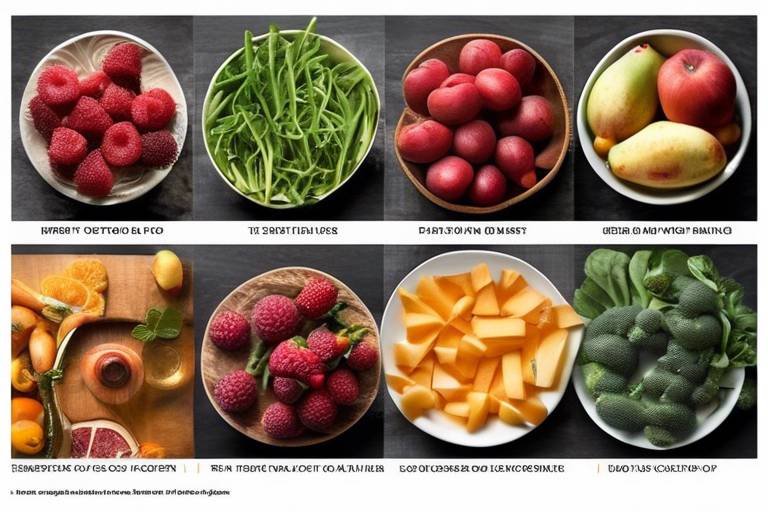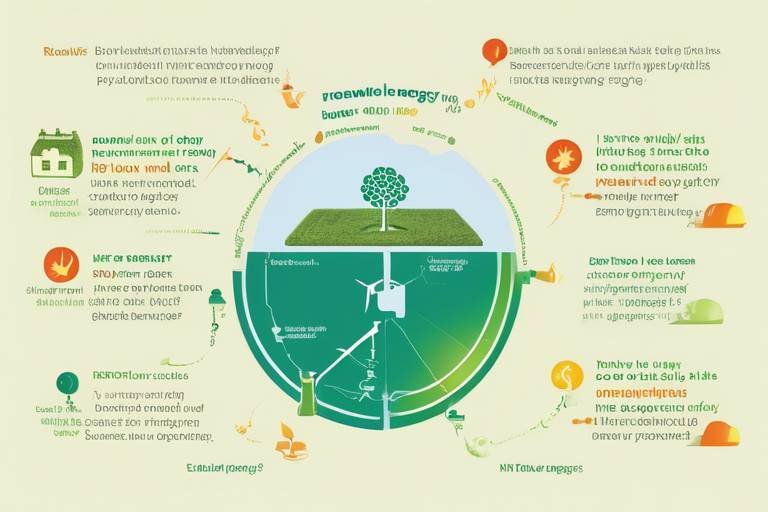10 Ways to Create a Sustainable Lifestyle
Living a sustainable lifestyle is not just a trend; it's a conscious choice that can positively impact the environment and our well-being. By making small changes in our daily routines, we can contribute to a greener future for generations to come. Here are 10 practical ways to incorporate sustainability into your life and make a difference:
1. Reduce, Reuse, Recycle: The mantra of the 3 R's is a powerful tool in minimizing waste and conserving resources. By reducing consumption, reusing items, and recycling materials, we can significantly reduce our environmental footprint.
2. Adopt a Plant-Based Diet: Transitioning to a plant-based diet not only benefits your health but also helps reduce the environmental impact of food production. Embrace more fruits, vegetables, and plant-based proteins to support a sustainable food system.
3. Conserve Energy: Implement energy-saving practices at home, such as using energy-efficient appliances, insulating your home, and switching to renewable energy sources like solar power. Small changes can lead to significant energy savings.
4. Embrace Minimalism: Simplify your life by decluttering and focusing on what truly brings you joy. Minimalism promotes mindful consumption, reduces waste, and encourages a more sustainable lifestyle.
5. Support Sustainable Fashion: Opt for clothing from ethical and sustainable brands that prioritize eco-friendly materials and fair labor practices. By making conscious fashion choices, you can reduce the environmental impact of the textile industry.
6. Cultivate a Green Thumb: Get your hands dirty and start gardening! Growing your own food not only connects you to nature but also promotes a sustainable way of living. Incorporate plants into your living space to improve air quality and create a greener environment.
7. Choose Eco-Friendly Transportation: Reduce your carbon footprint by opting for eco-friendly transportation options like biking, walking, carpooling, or using public transit. By minimizing reliance on fossil fuels, you can contribute to cleaner air and a healthier planet.
8. Practice Mindful Consumption: Be conscious of your purchasing decisions by supporting ethical brands, buying quality items that last longer, and avoiding unnecessary purchases. Mindful consumption not only reduces waste but also promotes a more sustainable economy.

Reduce, Reuse, Recycle
Explore practical tips and ideas to incorporate sustainability into daily life, reducing environmental impact and promoting eco-friendly practices.
Reducing, reusing, and recycling are essential practices in minimizing waste and conserving resources for a greener future. By reducing the amount of waste produced, reusing items whenever possible, and recycling materials, individuals can significantly contribute to environmental sustainability. These three actions form the foundation of a sustainable lifestyle, helping to lessen the burden on the planet and promote a more eco-friendly way of living.
When you reduce your consumption and opt for products with minimal packaging or in bulk, you are actively decreasing the amount of waste that ends up in landfills. Reusing items such as containers, bags, or clothing not only extends their lifespan but also reduces the need for new resources to be used in manufacturing. Recycling materials like paper, glass, and plastic allows them to be processed and turned into new products, conserving energy and raw materials.
Implementing the 3 R's into your daily routine can have a significant impact on the environment. By making conscious choices to reduce, reuse, and recycle, individuals can play a vital role in creating a more sustainable future for generations to come.

Adopt Plant-Based Diet
Explore practical tips and ideas to incorporate sustainability into daily life, reducing environmental impact and promoting eco-friendly practices.
Switching to a plant-based diet can have a significant impact on both your health and the environment. By focusing on fruits, vegetables, grains, and legumes, you not only reduce your carbon footprint but also support animal welfare. Plant-based diets are rich in nutrients, fiber, and antioxidants, offering numerous health benefits such as lower risk of heart disease and diabetes. Additionally, plant-based eating can be a delicious and diverse culinary adventure, opening up a world of new flavors and recipes.
Transitioning to a plant-based diet may seem daunting at first, but it can be done gradually. Start by incorporating more plant-based meals into your weekly menu and experimenting with different ingredients and cooking methods. Explore local farmers' markets or organic stores for fresh produce and sustainable food options. By making small changes over time, you can successfully adopt a plant-based diet that is both sustainable and satisfying.
When planning your plant-based meals, consider creating a balanced plate with a variety of colors and nutrients. Incorporate sources of protein such as beans, lentils, tofu, and quinoa, along with plenty of leafy greens and whole grains. Experiment with herbs and spices to enhance the flavors of your dishes without relying on animal products. By embracing a plant-based diet, you not only contribute to a more sustainable food system but also nourish your body with wholesome, plant-powered goodness.
If you find it challenging to give up certain animal products, remember that every plant-based meal makes a difference. You don't have to be perfect; even small changes in your diet can have a positive impact on your health and the planet. Joining online communities or local groups focused on plant-based eating can provide support, recipe ideas, and inspiration on your journey towards a more sustainable lifestyle.
Q: Is it difficult to get enough protein on a plant-based diet?
A: Not at all! Plant-based sources of protein include beans, lentils, tofu, tempeh, nuts, seeds, and whole grains. By incorporating a variety of these foods into your meals, you can easily meet your protein needs.
Q: Will I miss out on essential nutrients by going plant-based?
A: With proper planning, a plant-based diet can provide all the essential nutrients your body needs. Be sure to include a variety of fruits, vegetables, whole grains, nuts, and seeds in your diet to ensure you're getting a wide range of vitamins and minerals.
Q: How can I ensure my plant-based diet is sustainable?
A: Choosing locally sourced, seasonal produce and supporting organic farming practices can help make your plant-based diet more sustainable. Additionally, reducing food waste and composting organic scraps can further minimize your environmental impact.

Conserve Energy
When it comes to creating a sustainable lifestyle, conserving energy plays a crucial role in reducing our carbon footprint and promoting a greener future for generations to come. By implementing simple yet effective strategies, you can make a significant impact on the environment while also saving on energy costs.
One of the most effective ways to conserve energy is by ensuring your home is well-insulated. Proper insulation helps retain heat in the winter and keep your home cool in the summer, reducing the need for excessive heating or cooling. Additionally, sealing any drafts or leaks around windows and doors can prevent energy loss, making your home more energy-efficient.
Another way to conserve energy is by upgrading to energy-efficient appliances. Appliances such as refrigerators, washing machines, and air conditioners now come with energy-saving features that can significantly reduce electricity consumption. Look for appliances with the ENERGY STAR label, indicating they meet high energy efficiency standards.
Utilizing natural light and optimizing your lighting choices can also contribute to energy conservation. Make the most of daylight by opening curtains and blinds during the day, reducing the need for artificial lighting. When using light fixtures, opt for LED bulbs, which are not only energy-efficient but also have a longer lifespan compared to traditional incandescent bulbs.
Creating a habit of turning off lights, electronics, and appliances when not in use is a simple yet effective way to conserve energy. Standby power consumption, also known as vampire power, can account for a significant portion of your electricity bill. Unplugging devices or using power strips can help eliminate this phantom energy usage.
Investing in renewable energy sources such as solar panels or wind turbines is a proactive step towards a more sustainable lifestyle. Generating your own clean energy not only reduces your reliance on fossil fuels but also allows you to contribute excess energy back to the grid, promoting renewable energy adoption in your community.
Incorporating energy-saving habits into your daily routine, such as adjusting your thermostat settings, using programmable thermostats, and practicing water-saving techniques, can further enhance your efforts to conserve energy. Small changes can add up to significant energy savings over time, benefiting both the environment and your wallet.
By taking proactive steps to conserve energy in your daily life, you can play a vital role in mitigating climate change and preserving our planet's natural resources for future generations. Embracing energy conservation not only reduces your environmental impact but also sets a positive example for others to follow, creating a ripple effect of sustainable practices in our communities.

Embrace Minimalism
Explore practical tips and ideas to incorporate sustainability into daily life, reducing environmental impact and promoting eco-friendly practices.
Minimalism is not just about decluttering your physical space; it's a mindset that focuses on living with intention and purpose. By embracing minimalism, you can simplify your life, reduce waste, and cultivate a deeper appreciation for the things that truly matter. Imagine your life as a beautifully curated art gallery, with only the most meaningful and essential pieces on display. This approach can lead to a more sustainable lifestyle by encouraging conscious consumption and reducing the environmental footprint of excess stuff.
One way to embrace minimalism is to declutter your living space and let go of items that no longer serve a purpose or bring you joy. By streamlining your possessions, you can create a more organized and peaceful environment while reducing the urge to constantly buy more things. Consider investing in high-quality, versatile items that have a long lifespan, rather than accumulating cheap, disposable goods that contribute to landfill waste.
Minimalism extends beyond material possessions to other aspects of life, such as digital clutter and busy schedules. Take the time to simplify your digital life by organizing files, unsubscribing from unnecessary emails, and limiting screen time. Embrace the beauty of open space on your devices, just like you would in a clutter-free room.
By adopting a minimalist mindset, you can shift your focus from acquiring more things to appreciating the abundance that already surrounds you. It's about quality over quantity, mindfulness over mindlessness, and purpose over excess. Embracing minimalism can lead to a more sustainable lifestyle that prioritizes experiences, relationships, and personal growth over material possessions.

Support Sustainable Fashion
Are you tired of fast fashion's negative impact on the environment and human rights? It's time to embrace sustainable fashion and make a difference with your clothing choices. Supporting sustainable fashion means opting for clothing made with eco-friendly materials, ethical production practices, and a focus on longevity rather than trends.
By choosing sustainable fashion brands, you not only reduce the environmental footprint of your wardrobe but also support companies that prioritize fair labor practices and social responsibility. These brands often use organic cotton, recycled materials, and innovative sustainable fabrics to create stylish and durable clothing pieces.
One way to support sustainable fashion is by building a capsule wardrobe, consisting of versatile, high-quality pieces that can be mixed and matched for various outfits. This approach not only simplifies your wardrobe but also reduces the need for constant shopping and contributes to a more sustainable lifestyle.
Another way to promote sustainable fashion is by participating in clothing swaps or shopping second-hand. Thrifting not only gives clothes a second life but also reduces the demand for new clothing production, ultimately decreasing the fashion industry's environmental impact.
When shopping for new sustainable pieces, look for certifications like Fair Trade, Global Organic Textile Standard (GOTS), or OEKO-TEX, which ensure that the garments meet specific sustainability and ethical standards. Supporting sustainable fashion is not just a trend; it's a conscious choice to align your values with your fashion choices and contribute to a more sustainable future.

Cultivate a Green Thumb
Cultivating a green thumb goes beyond just growing plants; it's about nurturing a connection with nature and fostering a sustainable lifestyle. By tending to a garden, you not only beautify your surroundings but also contribute to a healthier environment. Imagine your hands in the soil, feeling the earth's energy as you plant seeds and watch them grow into vibrant flowers or nutritious vegetables.
Creating a sustainable living space with plants and greenery is not only visually appealing but also beneficial for the ecosystem. Plants help purify the air, provide oxygen, and create a harmonious balance in your home. Whether you have a spacious backyard or a cozy balcony, there are endless possibilities to cultivate a green oasis that supports biodiversity and enhances your well-being.
Consider starting a compost bin to reduce kitchen waste and nourish your plants with nutrient-rich soil. Composting not only minimizes landfill waste but also enriches the earth, creating a closed-loop system of sustainability. You'll be amazed at how a small act like composting can have a significant impact on the environment and your gardening endeavors.
Engaging in gardening activities can also be a therapeutic escape from the hustle and bustle of daily life. The act of planting, watering, and caring for plants can be a form of meditation that calms the mind and rejuvenates the spirit. Cultivating a green thumb is not just about growing plants; it's about cultivating a deeper connection with nature and embracing a more sustainable way of living.

Choose Eco-Friendly Transportation
When it comes to creating a sustainable lifestyle, one crucial aspect to consider is choosing eco-friendly transportation. By opting for alternative modes of travel, you can significantly reduce your carbon footprint and contribute to a more sustainable environment. Embracing eco-friendly transportation options such as biking, walking, or using public transit not only benefits the planet but also promotes a healthier and more active lifestyle.
Switching to eco-friendly transportation methods can have a positive impact on reducing air pollution and traffic congestion in urban areas. By choosing to walk or bike for short distances instead of driving, you not only reduce harmful emissions but also improve your overall well-being. Public transportation systems are also a great way to minimize the number of vehicles on the road, leading to less traffic and lower greenhouse gas emissions.
When considering eco-friendly transportation, it's essential to evaluate the environmental impact of your daily commute and travel habits. By carpooling with colleagues or using ride-sharing services, you can decrease the number of vehicles on the road and promote a more sustainable way of getting around. Additionally, investing in electric vehicles or hybrid cars can further reduce your carbon footprint and support the transition to cleaner transportation options.
Furthermore, incorporating eco-friendly transportation into your lifestyle can lead to cost savings and reduced dependency on fossil fuels. By using public transit or biking instead of driving, you can save money on fuel and maintenance costs while also contributing to a greener future. Sustainable transportation choices not only benefit the environment but also offer a more economical and efficient way to travel.
In conclusion, choosing eco-friendly transportation is a simple yet impactful way to promote sustainability in your daily life. By making conscious decisions about how you travel and considering alternative modes of transportation, you can play a significant role in reducing emissions and preserving the planet for future generations.

Practice Mindful Consumption
Exploring practical tips and ideas to incorporate sustainability into daily life is essential for reducing environmental impact and promoting eco-friendly practices. By making conscious choices and adopting sustainable habits, individuals can contribute to a greener future and a healthier planet.
Understanding the importance of the 3 R's - Reduce, Reuse, Recycle - is crucial in minimizing waste and conserving resources. By reducing consumption, reusing items whenever possible, and recycling materials, individuals can play a key role in creating a more sustainable world.
Discovering the benefits of a plant-based diet not only promotes personal health but also helps reduce the environmental impact of food production. Transitioning to a diet rich in fruits, vegetables, and whole grains can significantly lower carbon emissions and support sustainable agriculture practices.
Exploring strategies to reduce energy consumption at home is a great way to embrace a more sustainable lifestyle. From turning off lights and appliances when not in use to investing in renewable energy sources like solar panels, every effort counts towards a greener future.
Embracing the principles of minimalism and decluttering can lead to a simpler, more sustainable life with less waste. By focusing on quality over quantity and avoiding unnecessary purchases, individuals can reduce their environmental footprint and live more intentionally.
Learning about ethical fashion choices and supporting sustainable clothing brands is crucial for reducing the environmental impact of the fashion industry. By opting for eco-friendly materials, shopping second-hand, and embracing slow fashion, individuals can contribute to a more sustainable future.
Discovering the joys of gardening and growing your own food can not only provide fresh produce but also create a more sustainable living space. By cultivating plants and greenery, individuals can improve air quality, reduce stress, and connect with nature on a daily basis.
Exploring alternative transportation options such as biking, walking, or using public transit can help reduce carbon emissions and promote sustainable mobility. By choosing eco-friendly modes of transportation, individuals can contribute to cleaner air and a healthier environment.
When it comes to consumption, practicing mindfulness is key to making conscious and sustainable choices. By supporting ethical brands, making informed purchasing decisions, and reducing waste, individuals can embrace a mindful approach to consumption that benefits both the planet and future generations.
Frequently Asked Questions
- What are some easy ways to start living a more sustainable lifestyle?
Begin by incorporating simple habits such as reducing single-use plastics, conserving water and energy, and supporting local and eco-friendly businesses.
- How can I reduce my carbon footprint through transportation choices?
You can opt for carpooling, using public transportation, biking, or walking whenever possible to minimize emissions and contribute to a cleaner environment.
- Is it expensive to transition to a sustainable lifestyle?
While some eco-friendly products may have a higher upfront cost, there are many budget-friendly ways to embrace sustainability, such as thrifting, upcycling, and DIY projects.
- What role does sustainable fashion play in environmental conservation?
Sustainable fashion promotes ethical production practices, reduces textile waste, and encourages conscious consumerism, ultimately leading to a healthier planet and fairer working conditions.
- How can I make my home more energy-efficient?
Implement energy-saving practices like using LED light bulbs, insulating windows, unplugging electronics when not in use, and investing in renewable energy sources like solar panels.
- Why is mindful consumption important for sustainability?
Mindful consumption involves making informed choices, supporting ethical brands, and prioritizing quality over quantity, which helps reduce waste and minimize the negative impact on the environment.



















